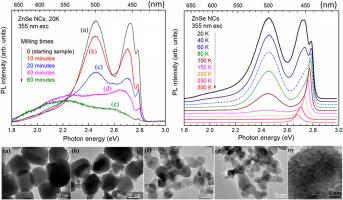ZnSe纳米晶球磨0-60分钟的温度依赖性光致发光
IF 3.6
3区 物理与天体物理
Q2 OPTICS
引用次数: 0
摘要
数十纳米尺寸的ZnSe纳米晶体作为一种真正的蓝光发射体在发光二极管中引起了人们的关注。水热法是制备100纳米左右的高质量ZnSe纳米材料的一种较好的、经济有效的方法;因此,为了获得理想尺寸范围为几十纳米的ZnSe纳米,后续的尺寸减小处理变得至关重要。球磨是减小ZnSe nc尺寸的一种简单有效的方法,但可能会引入结构缺陷。本文介绍了水热合成的各种ZnSe NCs的温度依赖性光致发光(PL)特性,并随后进行了球磨以评估其相应的光学性质。合成的ZnSe纳米粒子和经过10和20 min研磨的纳米粒子在2.79 eV (~ 444 nm)处具有窄激子发射带,在20 K处具有宽激子发射带,分别为~ 2.72 eV (453 nm)和2.46 eV (500 nm)。在150 K以上,由于后两者被热猝灭,只有激子发射保持在2.68 eV (~ 463 nm)。对于研磨40和60分钟的样品,激子发射明显减弱。通过分析20-300 K范围内温度相关的PL光谱,我们可以确定激子发射的活化能分别为70 meV、7 meV和10 meV, PL波段的峰值分别在2.72 eV和2.46 eV左右。讨论了观测到的PL波段的可能来源。本文章由计算机程序翻译,如有差异,请以英文原文为准。

Temperature-dependent photoluminescence of ZnSe nanocrystals ball-milled for 0–60 minutes
ZnSe nanocrystals (NCs) with sizes of several tens of nanometers have attracted renewed attention as true blue emitters in light-emitting diodes. The hydrothermal method is a preferable and cost-effective approach for producing high-quality ZnSe NCs with sizes around a hundred nanometers; therefore, subsequent size-reduction treatment becomes essential to obtain ZnSe NCs within the desirable size range of several tens of nanometers. Ball milling is a simple and effective method for reducing the size of ZnSe NCs, although it may introduce structural defects. This paper presents the temperature-dependent photoluminescence (PL) characteristics of various ZnSe NCs hydrothermally synthesized and subsequently ball-milled to assess their corresponding optical properties. The as-synthesized ZnSe NCs and those milled for 10 and 20 min show a narrow excitonic emission at 2.79 eV (∼444 nm) and broad bands at ∼2.72 eV (453 nm) and 2.46 eV (500 nm) at 20 K. Above 150 K, only the excitonic emission remains at 2.68 eV (∼463 nm), as the latter two are thermally quenched. For the 40- and 60-min milled samples, the excitonic emission is significantly weakened. Analyzing the temperature-dependent PL spectra over the 20–300 K range enables us to determine the activation energies of 70 meV, 7 meV, and 10 meV for the excitonic emission and the PL bands peaking around 2.72 eV and 2.46 eV, respectively. The possible origins of the observed PL bands are discussed.
求助全文
通过发布文献求助,成功后即可免费获取论文全文。
去求助
来源期刊

Journal of Luminescence
物理-光学
CiteScore
6.70
自引率
13.90%
发文量
850
审稿时长
3.8 months
期刊介绍:
The purpose of the Journal of Luminescence is to provide a means of communication between scientists in different disciplines who share a common interest in the electronic excited states of molecular, ionic and covalent systems, whether crystalline, amorphous, or liquid.
We invite original papers and reviews on such subjects as: exciton and polariton dynamics, dynamics of localized excited states, energy and charge transport in ordered and disordered systems, radiative and non-radiative recombination, relaxation processes, vibronic interactions in electronic excited states, photochemistry in condensed systems, excited state resonance, double resonance, spin dynamics, selective excitation spectroscopy, hole burning, coherent processes in excited states, (e.g. coherent optical transients, photon echoes, transient gratings), multiphoton processes, optical bistability, photochromism, and new techniques for the study of excited states. This list is not intended to be exhaustive. Papers in the traditional areas of optical spectroscopy (absorption, MCD, luminescence, Raman scattering) are welcome. Papers on applications (phosphors, scintillators, electro- and cathodo-luminescence, radiography, bioimaging, solar energy, energy conversion, etc.) are also welcome if they present results of scientific, rather than only technological interest. However, papers containing purely theoretical results, not related to phenomena in the excited states, as well as papers using luminescence spectroscopy to perform routine analytical chemistry or biochemistry procedures, are outside the scope of the journal. Some exceptions will be possible at the discretion of the editors.
 求助内容:
求助内容: 应助结果提醒方式:
应助结果提醒方式:


